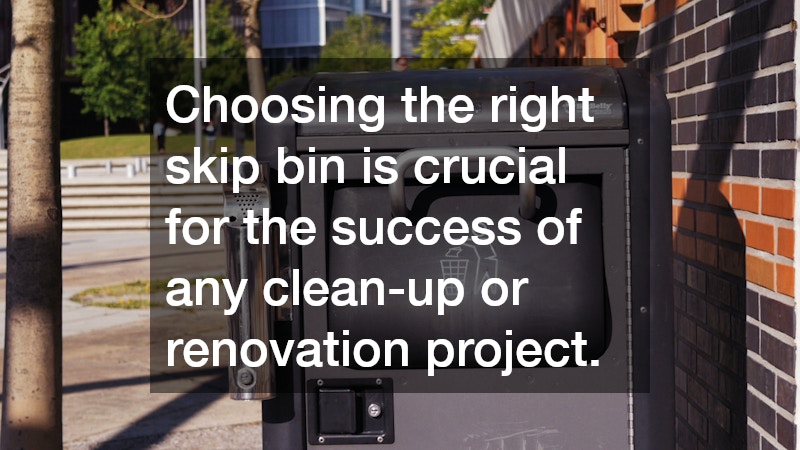Finding the right waste solution can make a significant difference when you’re planning a clean-up, renovation, or construction project. Choosing the correct skip bin is about more than just selecting the first option available—it requires consideration of size, type, and the kind of waste you’ll be disposing of. Making an informed choice will help you save time, money, and unnecessary hassle while ensuring your project remains efficient and environmentally responsible.
Assess the Scope of Your Project
The first step in choosing the right skip bin is to evaluate the scale of your project. A small spring clean may only require a mini bin, while a full renovation or construction job could necessitate a much larger solution. It’s common to underestimate how much waste a project can generate, which can lead to the inconvenience of having to order an additional bin or arrange multiple pickups. To avoid this, take time to estimate the amount of rubbish you expect to produce, including any bulky items such as furniture, broken appliances, or garden waste.
For residential jobs, skip bins typically range from two cubic metres to eight cubic metres. Commercial and industrial projects may require bins up to thirty cubic metres or more. A good rule of thumb is to overestimate slightly to ensure you have adequate space. It is more cost-effective to hire a single larger bin than to organise a second one later.
Understand the Types of Waste Allowed
Not all skip bins are created equal when it comes to what they can legally and safely contain. There are several different categories of waste, and choosing a skip bin that aligns with your specific waste type is essential to avoid penalties and contamination. General waste, green waste, construction debris, mixed heavy waste, and clean fill each require different handling and disposal methods.
If you’re disposing of household items and non-hazardous materials, a general waste skip bin is usually suitable. For garden projects, a green waste bin is a better choice. Construction jobs producing bricks, tiles, or concrete may require a dedicated construction waste bin to comply with local regulations. Hazardous materials such as asbestos, chemicals, and batteries typically cannot be placed in standard bins and require specialist disposal solutions. Always consult your provider about what is permitted, as mixing waste types can result in additional fees or even rejection of your bin upon collection.
Size Matters—Choose Wisely
Skip bins come in a wide range of sizes, and choosing the appropriate size can save you a lot of stress. Too small, and you may find yourself with excess waste and the need to hire again. Too large, and you might be paying for space you don’t use. Accurate estimation is critical. For example, a two cubic metre bin is ideal for small home clean-outs or garden waste, while four to six cubic metre bins are better suited to medium-sized renovation projects. Larger bins, such as ten cubic metres and above, are best for construction sites or major decluttering efforts.
Many skip bin companies provide visual size guides on their websites, often comparing bin volumes to standard wheelie bins or trailer loads. These guides can help you visualise the size you need based on what you plan to throw away. If in doubt, reach out to the supplier for advice—they can often recommend a size based on the type and amount of waste you expect to generate.
Consider the Placement & Access
Before your skip bin arrives, you must also consider where it will be placed. Skip bins need to be placed on level ground with clear access for the delivery truck. If your property has limited space or is on a busy street, you may need a permit from your local council to place the bin on public land. Planning the location in advance can help avoid delays and ensure the bin is easily accessible during your project.
Additionally, you should think about how you’ll load the bin. If you’ll be disposing of heavy materials like soil or bricks, a bin with a door or ramp will make it easier to wheelbarrow the contents inside. This is not only more convenient but also helps prevent injury from lifting heavy loads over the bin’s edge.
Work with a Reputable Supplier
Choosing a reliable skip bin provider is just as important as selecting the right bin. Look for a company with transparent pricing, flexible hire periods, and clear policies on what can and cannot be disposed of. A good provider will be licensed, fully insured, and committed to environmentally responsible waste disposal practices.
Customer service matters too. Suppose you’re unsure which bin to choose. In that case, a professional provider should be able to guide you through the decision process and answer any questions you have about weight limits, prohibited items, or pickup schedules. Positive reviews and recommendations from past customers can also indicate whether a provider is trustworthy.
Skip the Stress with the Right Bin
Choosing the right skip bin is crucial for the success of any clean-up or renovation project. By assessing your waste type and volume, selecting the correct size, planning your placement, and working with a reputable provider, you’ll simplify the entire process and avoid unnecessary issues. With thoughtful planning, a skip bin becomes a practical and efficient solution for waste removal that aligns with both your project goals and environmental values.



